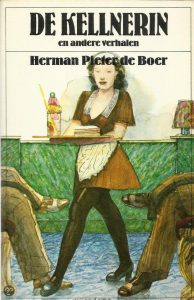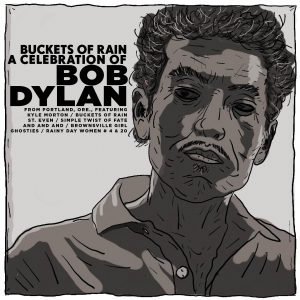by Jochen Markhorst
 An older couple strolls through a park in Rome, when the man is suddenly struck by a shocking insight: he does not love his wife at all. He shares this awareness with her, but it does not impress her that much – she stopped loving him long ago. “So you want to get divorced,” she deduces, undisturbed, and swiftly settles the necessities. “Give me money for the rest of the holiday and off you go.” Insecurely, the man obeys. But he does not feel liberated. Hours later he is still sitting in the dark on an ancient stone in the Colosseum, still a bit dazed. Perhaps it was all A Little Too Sudden, as the 1977 short story of Herman Pieter de Boer is called. It can be found in the collection De Kellnerin.
An older couple strolls through a park in Rome, when the man is suddenly struck by a shocking insight: he does not love his wife at all. He shares this awareness with her, but it does not impress her that much – she stopped loving him long ago. “So you want to get divorced,” she deduces, undisturbed, and swiftly settles the necessities. “Give me money for the rest of the holiday and off you go.” Insecurely, the man obeys. But he does not feel liberated. Hours later he is still sitting in the dark on an ancient stone in the Colosseum, still a bit dazed. Perhaps it was all A Little Too Sudden, as the 1977 short story of Herman Pieter de Boer is called. It can be found in the collection De Kellnerin.
The Rotterdam writer is inspired here by one of the many possible perspectives of “Simple Twist Of Fate”: the song can be understood as the swan song of an extinct love, a description of the physical breaking point, the point where the lovers actually part. The song does not let him go, hereafter. In 1983 De Boer writes the hit “Annabel” for Hans de Booij (top 5 in Belgium and The Netherlands) and this time he chooses another, more popular scenario: too late, the man realises that the one-night stand who just left was probably the love of his life (“But two hours later I was still awake, lying on my back”).
Also possible. Just like her big sister, “Tangled Up In Blue”, Simple Twist is not only ambiguous, but constantly on the move, too. The words change per performance, Dylan swaps personal pronouns, sometimes pushes the text in one direction (and then suggests that the lady’s love is paid for:
 She raised her weary head and couldn’t help but hate / Cashing in on a simple twist of fate),
She raised her weary head and couldn’t help but hate / Cashing in on a simple twist of fate),
then in another direction, when he reveals that the woman is called “Suze” (I remember Suze and the way she talked, June ’81 in London), the hotel where that last (or first and only ) night is consumed, is a strange hotel, a riverfront hotel, cheap, renovated and little, and sometimes gets a name: Grand Hotel, Rio Grande Hotel and Sainte Claire Hotel. The latter, by the way, being a notorious haunted hotel in San Jose – a strange hotel indeed.
It could be argued that the song, at least in its original design, was written with the first great love Suze Rotolo in mind. The subtitle in that sketching stage is “Fourth Street Affair” and that is not very cryptic – it refers to the apartment in which he and Suze live until August ’63, 161 West 4th Street. The reverie in the autobiography Chronicles, that Suze might have been his spiritual soul mate, lays out a second line (“I still believe she was my twin”) and it is also remarkable that Dylan uses the word fate here, when he records his memory of the end of the relationship with Rotolo: “Eventually fate flagged it down and it came to a full stop”.
It does not affect the strength of the poem, of course. Even with all those text changes, hardly any loss of quality occurs. The first verse and the perspective shift of the last verse are maintained, as is the walk along the old canal, and that is sufficient, apparently; many roads lead to Rome.
 Joan Baez, the first person to record a cover (on Diamonds And Rust, 1975), stands out because of her good-natured, very witty imitation of Dylan’s vocal style in the fourth verse, but also by fiddling around with the lyrics. Joan does not like parrots, that much is evident by now. When she ventures into Donovan’s “Legend Of The Girl Child Linda” (1967) together with her sister Mimi and Judy Collins, she mixes up the verses, gulls and doves are allowed to stay, but the verse with the parrot, where parrots are talking their words with such ease, has disappeared.
Joan Baez, the first person to record a cover (on Diamonds And Rust, 1975), stands out because of her good-natured, very witty imitation of Dylan’s vocal style in the fourth verse, but also by fiddling around with the lyrics. Joan does not like parrots, that much is evident by now. When she ventures into Donovan’s “Legend Of The Girl Child Linda” (1967) together with her sister Mimi and Judy Collins, she mixes up the verses, gulls and doves are allowed to stay, but the verse with the parrot, where parrots are talking their words with such ease, has disappeared.
In retrospect, the parrot allergy is apparent already in 1965, when Baez is very lucky that Dylan throws her “Farewell Angelina”. Since 1991, since The Bootleg Series 1-3, we know for certain that Joan has also rejected verses from that song: yes indeed, the verse with the camouflaged parrot. And the only other parrot in Dylan’s oeuvre, the one that emerges in “Simple Twist Of Fate”, Baez now also sneaky eliminates. Due to the comical parody of Dylan’s nasal vocal style in the fifth verse, it is hardly noticeable that she cunningly changes that original line of text and walks along with a parrot that talks into small waves whisper to the rocks.
The origin of the aversion is unclear. In her autobiography And A Voice To Sing With, Baez lavishly dwells on her illnesses, neuroses and anxieties, but she never once mentions psittacosis or ornithophobia (infectious diseases contracted from infected parrots).
Furthermore, the saxophone does not play in the distance, but “somewhere nearby” and the revision of the last verse seems to be a model for the later versions by the master himself:
People tell me it’s a crime
To feel too much at any one time
All it cost me was a dime but the bells refuse to ring
He was born in the spring but I was born too late
Blame it on a simple twist of fate
The Literals will be pleased with the gender change. Finally the birth in the spring is ‘right’ (Dylan was indeed born in the spring – Suze, Sara and Joan are all born too late, in autumn and winter).
But it is, as Dylan says in the radio interview with Paul Vincent (San Francisco 1980), not detrimental, not decisive for the content of the song. Nor for the beauty. Far more decisive is the classical form. In these days, the poet Dylan is rather addicted to his own version of an antique ballad form inspired by François Villon (1431-1463), recognisable by the repetition of a single line at the end of each stanza. On Blood On The Tracks he chooses this form for five of the ten songs (in Tangled, You’re Gonna Make Me Lonesome, Shelter and Jack Of Hearts) and also the outtake “Up To Me” is written around such a recurring verse.
The music is gorgeous. Simple enough, that descending melody line, but the fusion with the text is a brilliant find. It gives a magical sparkle to the rhyme scheme that on paper almost looks like an everyday rhyme (a a a b b c c). The sparse use of the minor chord is masterful too. Everyone else would, given the melancholic lyrics, play the entire song in minor. Song Maestro Dylan senses that he adds to the fascination when he plays in the major, briefly slipping to minor in every fourth line – when the main character feels alone, when he gets hit by the heat of the night, when he feels empty inside, when he is despairing if she would ever pick him again.
Finally, a true bonanza is the arrangement. That was soon found, apparently: at the first recording session an acoustic version is already being tried and three days later, September 19th ’74, at the second and last Simple Twist session, it is already final. Dylan’s guitar and his literally lyrical vocals, Tony Brown on bass and a beautiful harmonica solo – it is in working within limits that the master reveals himself, as Goethe taught us.
The majority of followers trip over this decree, over those limits, the less-is-more commandment. Beautiful covers, no question about it – but that sacred trinity of singing, lyrics and music is lost in the sublime blues version of the mourned Sean Costello (with Levon Helm on drums, 2004), Jeff Tweedy’s Desire approach, the chilling, majestic thriller of Concrete Blonde (Still In Hollywood, 1994), the dreamy, irresistible Jerry Garcia (live with the Jerry Garcia Band, 1991) … it is a long line of great renditions that do not come close to the original.
The covers that do come close are sober. Diana Krall, for example. The very talented Mrs. Elvis Costello has distinguished herself previously in Dylanland – in 2015, for example, with missionary work for the ignored wallflower “Wallflower”. She takes on Simple Twist alone, at the piano and equals the original’s quantity of goose bumps with her enchanting singing art (2012). On a sympathetic little hobby project from Portland, the 4-song-EP Buckets Of Rain (2011), there is a fascinating, bone-dry version by the little-known St. Even to be found. A bit dressed up, granted (background vocals, occasional strumming on a scanty guitar, a stark piano), but this one time it works out quite well, partly thanks to the intimate living room sound of the recording.
Ah well, the song is practically indestructible… some lonesome lady with a guitar suffices, as Mrs. Stevie Ann shows in a Dutch TV show, in 2011.
Joan Baez:
Sean Costello:
Jeff Tweedy:
Concrete Blonde:
https://www.youtube.com/watch?v=-WguPSDx1fc
Jerry Garcia Band:
Diana Krall:
Stevie Ann:
See also
- Simple twist of fate: a knife twists inside a simple song
- Prithee look back, there’s blood on the tracks
- Figurative Language in Blood on the Tracks
- Blake, Keats, And Spots Of Ink
- Bob Dylan Has His Blake
What else is on the site?
You’ll find an index to our latest posts arranged by themes and subjects on the home page. You can also see details of our main sections on this site at the top of this page under the picture.
The index to the 500+ songs reviewed is now on a new page of its own. You will find it here. It contains reviews of every Dylan composition that we can find a recording of – if you know of anything we have missed please do write in.
We also now have a discussion group “Untold Dylan” on Facebook. Just type the phrase “Untold Dylan” in, on your Facebook page or follow this link
And please do note The Bob Dylan Project, which lists every Dylan song in alphabetical order, and has links to licensed recordings and performances by Dylan and by other artists, is starting to link back to our reviews.


I think that Jimmy LaFave cover of the song is wonderful !
In ‘Tangled Up’, Dylan transmutes the objective of the Cubists to create the illusion of muti-dimensional ‘moving’ picture-paintings in time and space(though they’re operating on a media with flat surface) onto the words and music of a song.
Therefore, Dylan’s (and others)changing the nonlinear perspectives of the lyrics in variations of the song makes perfect sense.
Thanks …. fascinating piece and I agree with the view that the song like a lot of other of Dylan’s songs relate to his relationship with Suze Rotolo. Diana Krall’s version hits the mark fine for my ears. Cheers and keep up the good work.
The parrot that talks – could that be the voice in his head, the constant going over of events that becomes meaningless repetition?
We are actively promoting a link to this interesting topic on The Bob Dylan Project at:
https://thebobdylanproject.com/Song/id/573/Simple-Twist-of-Fate
If you are interested, we are a portal to all the great information related to this topic.
Join us inside Bob Dylan Music Box.